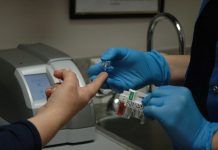Many older adults with diabetes whose health status was complex/intermediate to very complex/poor still maintained tight blood sugar control, which suggests a substantial proportion of older adults may be overtreated for diabetes because insulin and sulfonylureas can lead to hypoglycemia (low blood sugar), according to a report published online by JAMA Internal Medicine.
Diabetes is very common among adults 65 years or older, although optimal glucose management in this population remains poorly defined. Recommendations range from achieving a hemoglobin A1c level of less than 7 percent to less than 6.5 percent. However, older patients may derive less benefit from such intensive blood sugar control and may be more susceptible to hypoglycemia, a serious health threat that sends many patients to the hospital, according to background information.
Kasia J. Lipska, M.D., M.H.S., of the Yale School of Medicine, New Haven, Conn., and coauthors examined glycemic control levels in older patients with diabetes according to their health status to try to estimate potential overtreatment of diabetes.
The authors analyzed data on 1,288 adults (65 years and over) with diabetes from the National Health and Nutrition Examination Survey (NHANES) from 2001 through 2010. The patients were divided into three groups based on health status: very complex/poor (difficulty with two more activities of daily living or being dependent on dialysis); complex/intermediate (difficulty with two or more instrumental activities of daily living or having three or more chronic conditions; and relatively healthy (if none of the other conditions were present). Tight glycemic control was an HbA1c level less than 7 percent.
Of the 1,288 older adults with diabetes, 50.7 percent were relatively healthy, 28.1 percent had complex/intermediate health and 21.2 percent had very complex/poor health, according to the study. Overall, 61.5 percent of the adults had an HbA1c level less than 7 percent and this proportion did not differ across health status categories (62.8 percent were relatively healthy, 63 percent had complex/intermediate health and 56.4 percent had very complex/poor health). Of the adults with an HbA1c level less than 7 percent, 54.9 percent were treated with either insulin or sulfonylureas and this proportion was similar across health status categories (50.8 percent were relatively healthy, 58.7 percent had complex/intermediate health and 60 percent had very complex/poor health).
Continue Reading Below ↓↓↓
"Using a nationally representative sample of U.S. adults, we showed that nearly two-thirds of older adults with diabetes who have complex/intermediate or very complex/poor health attained tight glycemic control. These vulnerable adults are unlikely to experience the benefits of intensive glycemic control and instead are likely to experience harms from treatment, such as hypoglycemia and other adverse effects. Recognition of both the harms and benefits of glycemic control is critical for patients and physicians and other health care professionals to make informed decisions about glucose-lowering treatment," the study concludes.
JAMA Intern Med. January 12, 2015. doi:10.1001/jamainternmed.2014.7345.
Source: The JAMA Network Journals









